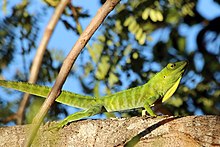Anolis garmani, also known commonly as the Jamaican giant anole, the Jamaican anole, and the Jamaica giant anole, is a species of lizard in the family Dactyloidae. The species is endemic to Jamaica, but has been introduced to Florida.
| Anolis garmani | |
|---|---|

| |
| At Strawberry Hill, Jamaica | |
| Scientific classification | |
| Domain: | Eukaryota |
| Kingdom: | Animalia |
| Phylum: | Chordata |
| Class: | Reptilia |
| Order: | Squamata |
| Suborder: | Iguania |
| Family: | Dactyloidae |
| Genus: | Anolis |
| Species: | A. garmani
|
| Binomial name | |
| Anolis garmani | |
| Synonyms[2] | |
| |
Etymology
editThe specific name, garmani, is in honor of American herpetologist Samuel Garman.[3]
Geographic range
editThe Jamaican giant anole is native to Jamaica. It has been introduced into Florida. There are recent records from Grand Cayman, but it is unclear if it has become established there.[4]
Habitat
editThe preferred natural habitat of A. garmani is forest, at altitudes from sea level to 1,300 m (4,300 ft), but it is also found on large trees in gardens.[1]
Description
editThe Jamaican giant anole is by far the largest species in the Norops group, with adult males having a snout–vent length (SVL) of 10–13.1 cm (3.9–5.2 in) and females 8–9.5 cm (3.1–3.7 in).[5] Adults are generally 20–30 cm (7.9–11.8 in) in total length, including tail,[6] with a maximum reported total length of 36.8 cm (14 in).[7]
Although generally green, it turns dark brown at night.[7] The male has an orange-centered yellow dewlap, which is small and dusky in the female.[6]
Behavior
editDiet
editA. garmani preys upon invertebrates and small anoles, and it also eats fruits.[1]
Reproduction
editSee also
editReferences
edit- ^ a b c d e Hedges, S.B.; Mahler, D.L.; Wilson, B.S. (2019). "Anolis garmani ". IUCN Red List of Threatened Species. 2019: e.T203884A2772001. doi:10.2305/IUCN.UK.2019-2.RLTS.T203884A2772001.en. Retrieved 18 November 2021.
- ^ a b c Species Anolis garmani at The Reptile Database www.reptile-database.org.
- ^ Beolens, Bo; Watkins, Michael; Grayson, Michael (2011). The Eponym Dictionary of Reptiles. Baltimore: Johns Hopkins University Press. xiii + 296 pp. ISBN 978-1-4214-0135-5. (Anolis garmani, p. 98).
- ^ Lever, Christopher (2003). Naturalized Reptiles and Amphibians of the World. Oxford, England: Oxford University Press. 344 pp. ISBN 0 19 850771 2. (Anolis garmani, p. 47).
- ^ Nicholson, Kirsten A.; Crother, Brian I.; Guyer, Craig; Savage, Jay M. (10 September 2012). "It is time for a new classification of anoles (Squamata: Dactyloidae)". Zootaxa. 3477: 1–108. doi:10.11646/zootaxa.3477.1.1.
- ^ a b Conant, Roger; Collins, Joseph T. (1998). A Field Guide to the Reptiles and Amphibians of Eastern and Central North America (3 ed.). Houghton Mifflin Harcourt. pp. 212–213. ISBN 978-0395904527.
- ^ a b Badger, David (2006). Lizards: A Natural History of Some Uncommon Creatures – Extraordinary Chameleons, Iguanas, Geckos, & More. Stillwater, Minnesota: Voyageur Press. p. 100. ISBN 978-0-7603-2579-7.
Further reading
edit- Schwartz A, Henderson RW (1991). Amphibians and Reptiles of the West Indies: Descriptions, Distributions, and Natural History. Gainesville: University of Florida Press. 720 pp. ISBN 978-0813010496. (Anolis garmani, p. 267).
- Schwartz A, Thomas R (1975). A Check-list of West Indian Amphibians and Reptiles. Carnegie Museum of Natural History Special Publication No. 1. Pittsburgh, Pennsylvania: Carnegie Museum of Natural History. 216 pp. (Anolis garmani, p. 83).
- Stejneger L (1899). "A New Name for the Great Crested Anolis of Jamaica". American Naturalist 33: 601–602. (Anolis garmani, new name, p. 602).
